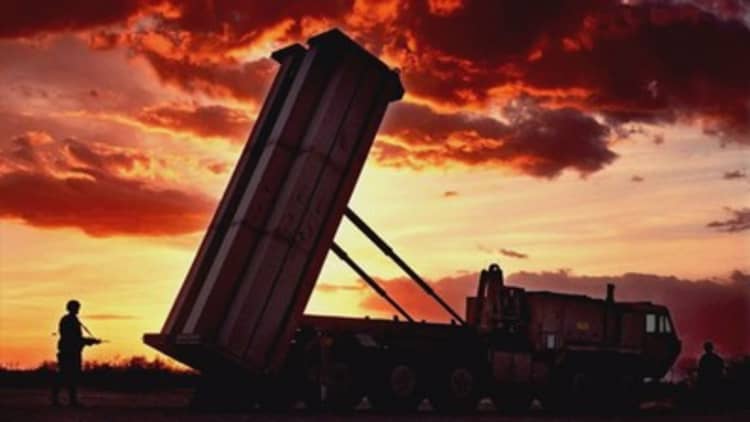South Korea is in no hurry to set up an advanced missile defense system designed to protect its shores from North Korean aggression despite fears of another intercontinental ballistic missile attack from its northern neighbor.
In June, South Korean President Moon Jae-in suspended further installation of the $923 million Terminal High Altitude Area Defense, or THAAD, pending a full review. That move was welcomed by China, who vehemently opposes the technology. And even as Kim Jong-un's regime threatens "merciless blows" to its enemies, Seoul isn't expected to shift its stance.
That's because the American hardware carries emotional political baggage for South Koreans, Jenna Gibson, director of communications at the Korea Economic Institute of America, wrote in a note published this week by the Center for Strategic and International Studies. "THAAD is not about China, or even the U.S. — it is about scandal-ridden former President Park Geun-hye."
The fact that THAAD was initiated by Park — the country's first democratically elected leader to be ousted from office via impeachment — is South Korea's core issue with THAAD, the note explained.
Park's image was greatly scarred once news broke of her role in a multi-million dollar corruption scandal last year. Backlash against her sparked months of mass street demonstrations that became known as the "Candlelight Revolution."
Many believe Park hurried through the deployment of THAAD's initial two missile launchers while she was still in office to prevent her successor from reversing the decision, according to Gibson.
The initial stages of THAAD deployment took place in South Korea earlier this year. The system, paid for by Washington, was tested last month when the U.S. shot down a simulated ballistic missile. However, the majority of South Koreans oppose sudden THAAD deployment, a May poll revealed.

"Demand for democracy is particularly high because of the candlelight revolution, and demand for democratic procedural legitimacy for the THAAD deployment is, therefore, high," Moon told the U.S. Congress earlier this month during a visit to Washington.
The former human rights lawyer, who also repeatedly questioned THAAD during his election campaign, reassured Congress that his demand for a probe wasn't a reversal of deployment plans.
In May, the president discovered that four additional THAAD missile launchers were installed without his knowledge — a realization that triggered an official probe into the entire system.
"These procedural issues, along with the fact that a full environmental review of the deployment area was not previously conducted, raised concerns among the Korean public," Gibson said.
The situation is a red flag for Washington, which has long pressed for swift missile defense implementation.
"I'm troubled by the fact that it is now going to be resubmitted for political debate in the Republic of Korea as to whether or not they will accept our $923 million investment in missile defense for their country," U.S. Sen. Dick Durbin said in a June 7 hearing. "I can't follow their logic here."

